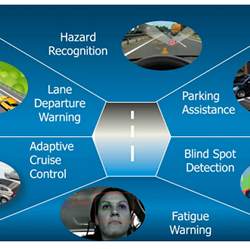
Self-driving cars appear poised to become the Next Big Thing. Automakers see serious benefits to putting machines in charge of driving. For one thing, accident rates would plummet: no more teenagers would text while driving, and forget about fatalities caused by impaired drivers. For another, trucking fleets would see a significant windfall when they can replace their drivers with a fleet of robots that can operate 24/7 without sleep—or pay.
A fully autonomous driving utopia is likely decades away. In the meantime, automakers are trying to bridge the gap between human-operated vehicles and self-driving conveyances with advanced driver assistance systems (ADAS), technological systems that make driving easier or safer by providing some (but not total) robotic driving autonomy.
Where a self-driving car is like your robot chauffeur, cars with ADAS are like your android driving instructors; they will alert you to danger and take steps to prevent it in many ways. Some signal when it appears you are about to hit an obstacle (or your elderly neighbor) while backing out of the driveway; others automatically adjust your speed on the highway to keep you a healthy distance from other cars, or steer you back if you inadvertently stray into the next lane. Some will hit the brakes for you with such speed and precision that you will avoid an accident before you even realize one was imminent.
Thanks to the utility of ADAS, the world’s most prominent automakers are rolling these systems out in current and future models.
Stopping accidents before they happen
Prevention, whether of accidents or stress, seems to be the watchword of ADAS.
Volkswagen, as one example, offers cars featuring adaptive cruise control (which regulates the vehicle’s distance from other cars), forward-collision warnings with autonomous emergency braking, and a monitor for blind spots, says Mark Gillies, manager of Product and Technology Communications for Volkswagen of America. The company’s forward collision warning systems use one or more sensors that work in tandem with a camera that monitors traffic ahead of the vehicle; the car warns you if a collision may occur, and automatically brakes in an emergency.
Gillies finds it "likely" the firm will introduce pedestrian recognition systems, which employ sensors to detect pedestrians that step into the road, in its 2017 U.S. models. Many European models already have ADAS features, he says.
Ford offers similar automatic emergency braking, as well as software that auto-adjusts a vehicle’s speed if needed. Ford cars will also help prevent the stress of parallel or perpendicular parking, says Whitney Pineda of the Ford press relations team, thanks to a combination of sensors and cameras that work together to orient the car perfectly in a parking spot.
A number of Mercedes-Benz models include a "Driver Assistance Package" with stereoscopic cameras that look 160 feet in front of your car 17 times per second to sense traffic patterns and pedestrians, says Christian Bokich of the company’s product and technology communications department. Bokich says the system aims to autonomously intervene to protect drivers or "enhance driving" if an accident is imminent. This tech has been available as of model year 2015 in the current E-Class, the new 2015 C-Class, the Mercedes-Maybach S600, and the GLE models, among others. This year’s GLS and S-Class Cabriolet will also feature the technology, says Bokich.
BMW Group offers advanced driver assistance systems in models like the BMW 7 Series, which sports steering and lane-control assistance, side- and rear-collision detection, and a traffic jam assistant with semi-automated driving. While BMW would not comment on anticipated improvements to future models, it does see highly automated driving as a major benefit to tomorrow’s cars, says Manfred Poschenrieder, a company spokesman.
From On Call to In Charge
Ford plans to broaden its ADAS offerings with even more capabilities in the next three years, says Ford’s Pineda. The company is currently working to develop Traffic Jam Assist, a"semi-autonomous technology that assists the driver with steering, braking, acceleration, and keeping the vehicle centered in the lane during traffic jams."
Another ADAS technology Ford has in development is Fully Active Park Assist, which helps drivers by steering and controlling the transmission, throttle, and brake to pull into a parking spot with the press of a button.
Charging hard towards a more autonomous future along with Ford is Tesla. In October 2015, Tesla began to introduce autonomous features via software update to its models on the road. Called Autopilot, the feature provides automatic steering, lane changing, and an auto-park feature.
The new Mercedes 2017 E-Class also sports some next-generation ADAS. Its Pre-Safe Sound feature emits a signal to reduce hearing loss by preparing one’s ears for the extremely loud noises that can occur during a car crash. Another safety measure preventatively moves the driver or front-seat passenger up to 2.75 inches away from a lateral impact zone before a collision occurs.
General Motors plans to have its cars talk to other vehicles. The company will deploy vehicle-to-vehicle (V2V) technology in the Cadillac CTS later this year and will launch its Super Cruise hands-free driving technology in the Cadillac CT6 in 2017, says Kevin Kelly, General Motors senior manager of global advanced technology communications.
At Ford, in addition to driver assist technology, the company "is seeking to deliver autonomous capability that does not require driver input, described by the SAE International [the Society of Automotive Engineers] as Level 4 of automation," says Pineda. "At this level of capability, autonomous vehicles will likely be offered first in climates that support optimal sensor performance and in areas that have been mapped in high-resolution 3D."
Logan Kugler is a freelance technology writer based in Tampa, FL. He has written for over 60 major publications.



Join the Discussion (0)
Become a Member or Sign In to Post a Comment